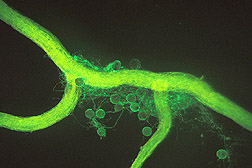This page has been archived and is being provided for reference purposes only. The page is no longer being updated, and therefore, links on the page may be invalid.
Glomalin: A Key to Switchgrass Ethanol Success
By Don ComisOctober 12, 2007
If switchgrass succeeds as an ethanol crop, it will owe some of its success to glomalin, the key ingredient of soil organic matter.
Glomalin was discovered in 1996 by Agricultural Research Service (ARS) soil scientist Sara F. Wright—now retired—and ARS microbiologist Kristine A. Nichols, then both at Beltsville, Md. Nichols is now at the ARS Northern Great Plains Research Laboratory in Mandan, N.D., where glomalin work continues.
A sugar protein, glomalin is excreted by soil fungi and helps them funnel water and nutrients into plant roots. It also helps store carbon in the soil and acts as a “glue” to hold soil particles together.
In assessing glomalin levels and their role in biofuel crops, Nichols has measured higher levels of glomalin in the roots of switchgrass, big bluestem and other warm-season grasses than in the roots of cool-season grasses such as wheatgrass and Russian wild rye. Switchgrass is a fast-growing, warm-season perennial with potential as a feedstock for cellulosic ethanol production.
Preliminary results show that warm-season grasses such as switchgrass and big bluestem also give soil more stability. Nichols found a strong association between warm-season grasses and the arbuscular mycorrhizal fungi that live on plant roots and produce glomalin.
Glomalin may be partly responsible for the ability of switchgrass to store more soil carbon than corn—and to store it deeper, so it’s less likely to be lost to the atmosphere as carbon dioxide. Thus, glomalin might not only help biofuel crops grow and flourish under adverse conditions like drought, but also close the carbon cycle by storing carbon released as carbon dioxide during the burning of biofuels for energy.
Nichols’ work could help growers know how to best establish switchgrass, and to make sure as much carbon as possible is stored below ground.
ARS is the U.S. Department of Agriculture's chief scientific research agency.

